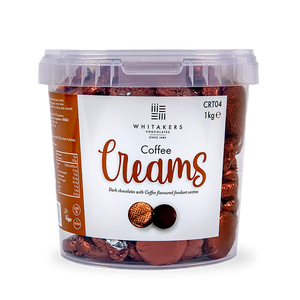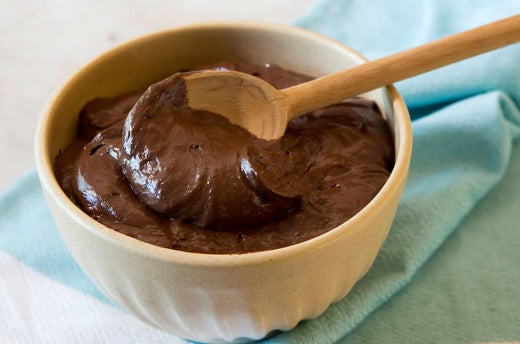Hello, chocolate enthusiast!
In this post, we are going to dive into the deliciously complex world of chocolate and address a common question when deciding on which type of chocolate to use in our baking or snacking.
The question at hand is: What is the difference between bittersweet and semisweet chocolate?
Often found side by side on supermarket shelves, these two varieties of dark chocolate are staples in many recipes and are favourites among those of us who enjoy a less sweet, more cocoa-forward chocolate.
However, the distinction between the two can be somewhat murky.
In this post, we're going to decode the differences between bittersweet and semisweet chocolate, explore their unique characteristics, and provide some guidance on when to use each type.
What Is the Difference Between Semisweet and Bittersweet Chocolate?
Semisweet and bittersweet chocolates are both types of dark chocolate and are often used interchangeably in baking.
The primary difference between bittersweet and semisweet chocolate lies in their sugar and cocoa content.
Semisweet chocolate typically has a lower cocoa content, usually around 50-60%, and a higher sugar content, which gives it a sweeter taste.
It's considered a good all-around chocolate for baking.
Bittersweet chocolate, on the other hand, has a higher cocoa content, generally around 70% or higher, and less sugar, which results in a deeper, more bitter flavour.
However, there's considerable overlap, and the exact ratios can vary between different brands and regions, meaning bittersweet chocolate from one brand might taste similar to a semisweet from another.
Always check the cocoa content on the packaging if you're looking for a specific flavour profile.
(Click here if you want to read: How Much Cocoa is there in Milk Chocolate?)
What is Bittersweet Chocolate?
Bittersweet chocolate is a type of dark chocolate that typically contains a high percentage of cocoa solids and less sugar than other types of chocolate.
This results in a rich, intense chocolate flavour that can be quite bitter, hence the name.
The cocoa content in bittersweet chocolate usually ranges from 70% to 85%, although it can be higher in some brands.
Because of its high cocoa content, bittersweet chocolate is often less sweet and has a deeper, more complex flavour profile than semisweet or milk chocolate.
Aside from cocoa and sugar, bittersweet chocolate may also contain cocoa butter and vanilla, and it may also contain lecithin, an emulsifier that helps blend the ingredients together.
Bittersweet chocolate is often used in baking and dessert recipes where a strong, robust chocolate flavour is desired.
It's also enjoyed on its own by those who prefer less sweet, more cocoa-forward chocolate.
As with all chocolates, the quality can vary widely between brands, so it's worth seeking out a high-quality bittersweet chocolate for the best flavour.
What is Semisweet Chocolate?
Semisweet chocolate is a type of dark chocolate that, as its name suggests, offers a balance between sweet and bitter flavours.
It has a lower cocoa content compared to bittersweet chocolate, typically ranging around 50-60%, and contains more sugar, making it a sweeter choice.
Ingredients in semisweet chocolate generally include cocoa, sugar, and cocoa butter.
It may also include vanilla and an emulsifier such as soy lecithin.
The exact balance of these ingredients can vary between manufacturers, leading to differences in taste and texture.
Semisweet chocolate is a popular choice for baking, often used in cookies, brownies, ganaches, and many other dessert recipes due to its balanced flavour profile that isn't too sweet or too bitter.
It's also a common choice for chocolate chips.
It's a versatile choice that can cater to a wide range of tastes, from those who enjoy the rich, complex flavours of dark chocolate but still appreciate a touch of sweetness.
As always, the quality and taste can differ between brands, so it's worth trying a few to find one that suits your palate.
(Click here if you want to read about: What Percentage is Semi-Sweet Chocolate?)
What Is the Taste Difference Between Semisweet and Bittersweet Chocolate?
The taste difference between semisweet and bittersweet chocolate primarily lies in their sweetness and intensity of the cocoa flavour due to the varying proportions of cocoa and sugar in each.
Semisweet chocolate, with a cocoa content usually around 50-60%, is milder and sweeter.
It has a balanced flavour, offering a medium level of bitterness that's complemented by a higher proportion of sugar.
On the other hand, bittersweet chocolate has a higher cocoa content, typically 70% or higher, resulting in a more intense, deep chocolate flavour with less sweetness.
The increased percentage of cocoa solids gives it a richer and more robust taste, with a noticeable bitterness.
However, there can be overlap between the two, and the exact taste can vary between different brands and specific products.
It's always a good idea to taste the chocolate before using it in a recipe to ensure it delivers the flavour profile you're looking for.
Are Semisweet and Bittersweet Interchangeable for Recipes?
Generally speaking, semisweet and bittersweet chocolates can be used interchangeably in most recipes.
Both are types of dark chocolate and while they do have different cocoa contents and levels of sweetness, these differences are often subtle enough that they won't dramatically alter the outcome of a recipe.
However, the specific flavour profile you want in your finished dish could influence your choice.
If you prefer a sweeter, less intense chocolate flavour, go for semisweet chocolate.
If you're after a deeper, more robust chocolate taste with less sweetness, opt for bittersweet.
Remember, too, that the definitions of 'semisweet' and 'bittersweet' can vary between brands, so it's always a good idea to taste the chocolate before you use it.
If a recipe specifically calls for one or the other and you care about getting the intended result, it's best to stick with what's recommended.
In the end, the best guide is your own palate.
If you prefer the taste of one over the other, feel free to use that, as enjoying the food you cook is the most important thing.
Some Notes From a UK Chocolate Expert
While the terms "bittersweet" and "semisweet" are commonly used in the United States to denote different types of dark chocolate, they might not be as familiar to us ‘UK’ chocolate lovers.
In the UK, we tend to categorise our chocolate more by the specific cocoa content, with dark chocolate often labelled with the percentage of cocoa it contains.
You'll commonly see dark chocolate bars with labels like "70% cocoa" or "85% cocoa" on supermarket shelves.
These percentages give you a good indication of how intense the chocolate flavour will be, with higher percentages generally providing a more robust, less sweet chocolate taste.
"Bittersweet" and "semisweet" are terms you're more likely to encounter when following American recipes or looking at imported chocolate products.
If you do come across them, remember that "semisweet" is generally a sweeter, less intense chocolate (akin to a lower-percentage dark chocolate in the UK), while "bittersweet" is less sweet and has a deeper, more robust chocolate flavour (similar to a higher-percentage dark chocolate).
As always, the best guide is your own taste buds.
If you prefer a less sweet, more intense chocolate, opt for higher percentages or "bittersweet".
If you like your chocolate a bit sweeter, go for lower percentages or "semisweet".
And don't be afraid to experiment - part of the joy of cooking and baking with chocolate is discovering your own personal preferences!
What Makes a Good Substitute for Semi-Sweet Chocolate?
When it comes to substituting semi-sweet chocolate in a recipe, there are a few options you can consider:
-
Dark Chocolate: A bar of dark chocolate with a cocoa content around 60% can be a good substitute for semi-sweet chocolate. Dark chocolate is less sweet, so you may need to adjust the sugar in your recipe to account for this.
-
Milk Chocolate: If you prefer a sweeter taste, milk chocolate can be used as a substitute. However, keep in mind that it's considerably sweeter and contains less cocoa, so it may change the flavour and texture of the final product.
-
Chocolate Chips: Semi-sweet chocolate chips can be a handy substitute if you're in a pinch. They're designed to hold their shape when baked, so they may not melt as smoothly as a bar of chocolate.
-
Cocoa Powder: If you don't have any form of chocolate on hand, you can use cocoa powder as a last resort. Mix one tablespoon of cocoa powder with one tablespoon of sugar and two teaspoons of unsalted butter for every ounce of semi-sweet chocolate.
-
Bittersweet Chocolate: While bittersweet chocolate has a higher cocoa content and less sugar than semi-sweet chocolate, it can be used as a substitute in most recipes.
Remember, each of these substitutes can alter the flavour and texture of your recipe, so choose the one that best suits your taste preferences and the recipe you're following.
What is the Best Type of Chocolate for Cooking and Baking?
The best type of chocolate for cooking and baking largely depends on the recipe you're following and your personal taste preferences.
However, here are some general guidelines for different types of chocolate:
-
Dark Chocolate: With its robust, rich flavour, dark chocolate is a versatile choice for many recipes. It's available in different cocoa percentages, allowing you to choose based on how intense you want the chocolate flavour to be. It's excellent for ganaches, truffles, and any recipe where a deep chocolate flavour is desired.
-
Semi-Sweet and Bittersweet Chocolate: These are types of dark chocolate, often used interchangeably in recipes. They're great for baking due to their balanced sweetness and cocoa flavour. Ideal for cookies, brownies, and many other desserts.
-
Milk Chocolate: Sweeter and creamier than dark chocolate, milk chocolate is best used in recipes where a milder, sweeter chocolate flavour is desired. It's great for making chocolate sauces and fillings, or for use in desserts where its sweetness complements other ingredients.
-
White Chocolate: Although it doesn't contain cocoa solids, white chocolate brings a creamy, sweet, and slightly vanilla flavour to dishes. It can be used in baking, though it's more sensitive to heat than other types of chocolate.
-
Couverture Chocolate (like Whitakers Easymelt product): This is a high-quality chocolate that contains a higher percentage of cocoa butter. It's excellent for tempering and making chocolate decorations due to its smooth texture and shiny finish when melted and cooled.
-
Cocoa Powder: Ideal for adding a chocolatey flavour to cakes, biscuits and frostings, cocoa powder is a staple in many baking recipes. It provides a strong, bitter chocolate flavour without adding any fat or sweetness.
Remember, when it comes to cooking and baking with chocolate, the quality matters.
Higher-quality chocolate will generally produce better results, so it's worth investing in good chocolate, especially for recipes where chocolate is the star of the show.
Final Notes On The Difference Between Bittersweet and Semisweet Chocolate
Understanding the difference between bittersweet and semisweet chocolate can be useful when baking or cooking with chocolate.
Both are types of dark chocolate that differ primarily in their cocoa content and sweetness.
Bittersweet chocolate typically has a higher cocoa content (around 70% or more) and less sugar, providing a rich, deep, and robust chocolate flavour with a noticeable bitterness.
It's ideal for recipes where a strong chocolate presence is required.
Semisweet chocolate has a lower cocoa content (usually around 50-60%) and contains more sugar, offering a balanced chocolate flavour that isn't too sweet or too bitter. It's a versatile choice that works well in a wide variety of recipes.
While these two types of chocolate can often be used interchangeably in recipes, the specific taste profile you're aiming for could influence your choice.
It's also worth noting that in the UK, we typically categorise our chocolate by the specific percentage of cocoa it contains rather than using terms like "semisweet" and "bittersweet", which are more common in the US chocolate industry.
However, understanding these terms can be useful when following international recipes or buying imported chocolates.
At the end of the day, the best chocolate for any dish is the one that most appeals to your personal taste preferences.
Happy cooking and baking with chocolate!






















